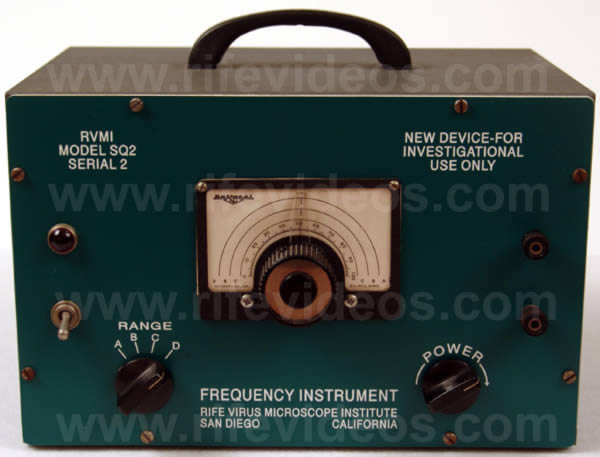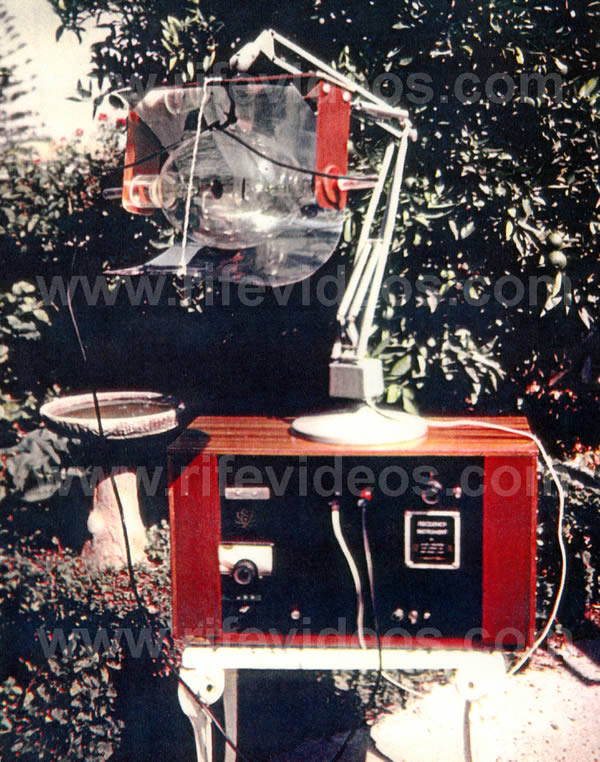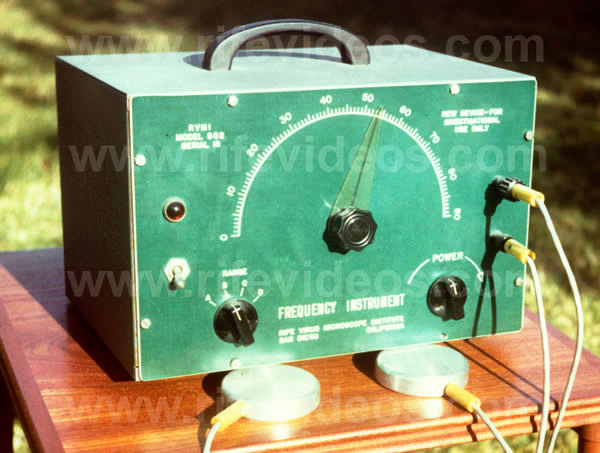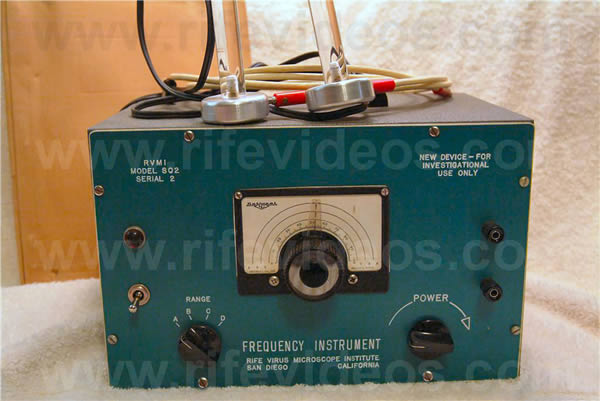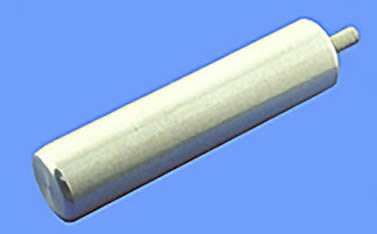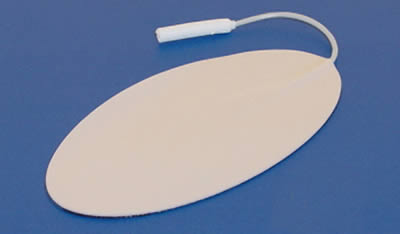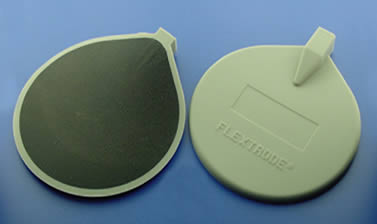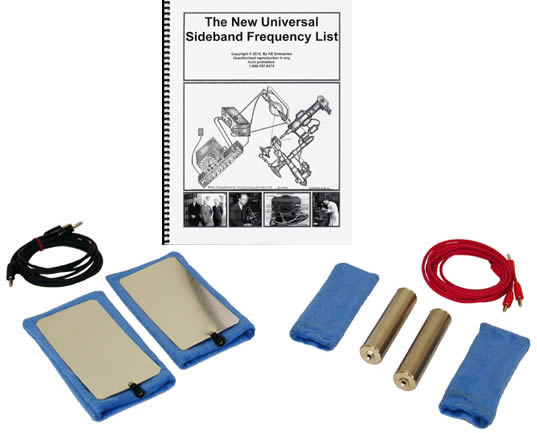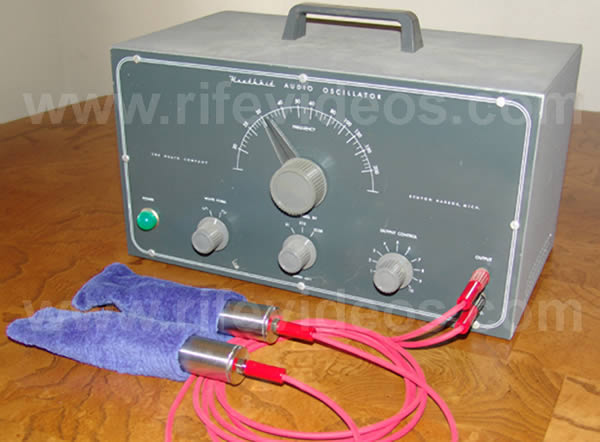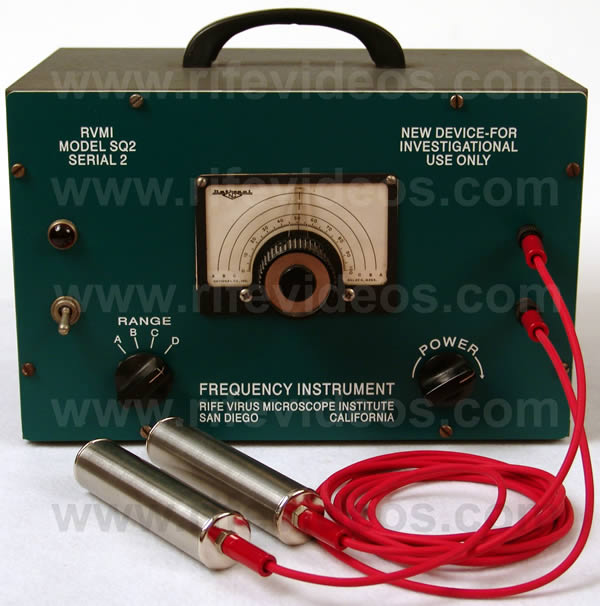| Home | Accessory Kit | Marsh CD Collection | Library | Contact Us |
How to make any
frequency generator with the right frequency
range and power output work like a Rife Machine.
How does a person make any frequency generator with the proper frequency range and power output work like a Rife Machine. There are two important factors that determine how well a frequency generator will work. The first is the frequency range and the second is the power output.
Most of the so called “Rife Machines” on the market today do not have the ability to output the correct frequency range that Dr. Rife used. A frequency generator with a frequency range from 1 Hertz to about 4 MHz (4 million Hertz) would be adequate. If it had a higher frequency range that would go up to about 20,000,000 (20 million Hertz it would be better.
Any reasonable person can understand that if a frequency generator cannot output the original frequencies that Dr. Rife found for the various microorganisms then how can that frequency generator possibly work like Dr. Rife's original instruments did. This is not rocket science, it is just basic common sense. Yet, today many sell frequency generators, which they call "Rife Machines," that are incapable of outputing Dr. Rife's original frequencies. Below is a link to a page about Dr. Rife's original frequencies.
To read about Dr. Rife's Original Frequencies click here.
Above, in the photo, is one of the first frequency generators developed by Dr. Rife's two business partners John Crane and John Marsh. Dr. Rife did not develope this type of instrument. It was built back in the late 1950's. It used round metal disks that came in contact with the body. Later people changed these and used metal hand cylinders and footplates instead. These are still used today. This frequency generator could not output any of Dr. Rife's original frequencies. John Crane and John Marsh made the mistake of believing that only the audio frequencies were important. Yes, the audio frequencies were important but they were only half of the two frequency equation or combination. The audio frequencies needed to be used with an RF or radio frequency carrier. The combination of the audio frequencies and the RF radio frequencies created additional frequencies called harmonic sideband frequencies. It was one of these harmonic sideband frequencies that would line up with Dr. Rife's original frequency which he found that would devitalize or render harmless the harmful microorganism. Dr. Rife did not like the fact that John Crane and John Marsh had changed the way the machine worked. The hand cylinders and footplates were not the problem, instead it was the fact that the new instrument was not capable of outputing Dr. Rife's original frequencies. When Dr. Rife's attorney, Bertrand Comparet, asked him about the change that John Crane and John Marsh made, Dr. Rife made the following statement. We quote:
COMPARET: “And I asked Rife, because I thought Rife would certainly say that the way Crane was working on it then was still using the Rife principle, but he indignantly denied it.”
DR. HUBBARD: "All right, I see. But, getting back, you say that Rife was very indignant, that the machine that Crane was building was really his [Cranes] idea. I suppose he did not compromise on that, did he?
COMPARET: "Oh no, he just blew up." (1970's Comparet interview papers #32 & 40)As can be seen by this quote John Crane and John Marsh's new style frequency generator was not working on Dr. Rife's principles which included the proper frequency range. Dr. Rife's original frequency range went from 139,000 Hertz to about 1,608,000 Hertz. When the 1936 Rife Ray #5 or Beam Ray clinical instrument was built it used higher frequencies that were higher harmonics of Dr. Rife's original frequencies. These new higher frequencies were in the 2 to 3 million Hertz range (2 or 3 MHz range). For this reason a frequency generator with a 4 million Hertz range will work very well. Some of Dr. Rife's earlier frequencies went as high as about 18 million Hertz and this is why a 20 million Hertz range frequency generator makes it possible to also have access to these higher frequencies which people may want to use.
Now we will discuss the second factor that determines how well a frequency generator will work and this is the power output of the frequency generator. Many of the so called "Rife Machines" built today are also UNDER-POWERED. But they may work for some less serious problems that people may be suffering from. Both John Crane and John Marsh understood that their new low power hand cylinder and footplate instrument was only good for small areas of the body. Below we quote from the "Electron Therapy" report of 1959:
Electron Therapy: "In the last years this technique has received new impetus due, on one hand...to the discovery of direct application to the body [Metal hand cylinders and footplates] without the need of an applicator tube [Ray tube]. The problem of adequate coverage with this method is manifold as only small areas of the body are treated at one time with a single instrument. Additional amplification with metal harnesses or electrodes covering many areas simultaneously are contemplated for future development." (Electron Therapy Report).
From this quote we can see that both John Crane and John Marsh understood that this new style of instrument was UNDER-POWERED and worked best on small areas of the body. We will now explain what factors limit these types of frequency generators and how this limit can be corrected.
The original metal hand cylinder and footplate instrument, shown in the photo above, used a maximum 1/5 (0.20) of one watt of energy output. This power level has been used since the 1950's. But instruments that output about 1.5 to 15-watts are necessary for best results when using hand cylinders and footplates. Most of the so called "Rife Machines," which are nothing more than average frequency generators, only output about 1/5 or 0.20 of one watt of power. Due to the impedance or resistance of the body they may have less than one half (0.10) of that 0.20 of one watt actually get into the body. So more than 50% of the instrument’s power may be lost just trying to overcome the body’s resistance to electrical current. The reason these so called "Rife Machines" only output about 0.20 of one watt is because they use only low audio frequencies. Generally, the body cannot handle any more power than about 0.20 of one watt using low audio frequencies. Low audio frequencies between 1 Hertz and about 20,000 Hertz can be felt on your skin and if more than 0.20 of a watt of voltage and current are used then the electrical current will enter the body and begin locking up the muscles.
There is only one way to overcome the body’s resistance and get sufficient power into the body without locking up the muscles using hand cylinders and footplates. An RF or radio carrier frequency has to be used. Dr. Rife’s original machines all had the capability of using an RF carrier frequency. His 1936 Rife Ray #5 or Beam Ray Clinical instrument built by his engineer, Philip Hoyland, used audio frequencies modulated (Piggybacked) onto an RF carrier frequency. The use of an RF carrier frequency overcomes the body’s resistance and allows for a much higher power transfer of the frequencies into the body. But even with an RF carrier frequency you will have some power loss due to the resistance of the body. Even with this loss of power it still allows for the use of up to 150 times more power than 0.20 of one watt. Anyone can understand that this would be a great deal more power to work with. More power will produce better results.
Please keep in mind that the machines we have been discussing are those that use metal hand cylinders or footplates. The single Ray Tube machines that Dr. Rife used were very powerful instruments. The power output of these original Ray Tube Rife Machines ranged from about 50 watts to about 600 watts. His Rife Ray #5 or Beam ray clinical instrumen output 75 watts. With this kind of power the body’s impedance or resistance has no effect. There are some companies that sell their “Rife Machines” with hand-held ray tubes that they claim output between 2 to 30-watts. But every test done with certified watt-meters that are designed to measure power output show that none of these hand-held ray tube instrument output more than 2-watts even though they claim 30-watt power output.The output energy is alternated back and forth between the two ray tubes. It is implied that these hand-held ray tubes work better than metal hand held cylinders and footplates but the evidence does not support this false claim.
To read about how metal hand cylinders compare to hand held ray tubes click here.
Logically these two hand held ray tubes cannot compare to Dr. Rife's more powerful 50 to 75-watt ray tube instruments that he used. Dr. Rife first used about 8 to 10 watts (To read the 1938 newspaper article where Dr. Rife stated this click here) of power on the first organisms he worked on. This amount of power was sufficient for a test tube or a slide put under his microscope. But Dr. Rife found that he needed about 50 watts to have the full effect inside the body. This is due to the impedance or resistance of the tissue of the body.
Because the glass of a ray tube is not the same as a metal conductor, such as metal hand cylinders and foot plates, there is less power transferred using hand held ray tubes when you compare two instruments of equal power output. The fact is metal hand cylinder instruments can output the same amount of power as hand held ray tube instruments. The major advantage of metal hand cylinders is you have 100% of the energy transferred to the body because metal is almost a perfect conductor. But hand held ray tubes are made of glass and glass does not have the same conductive properties as metal so about 50% of the energy is not directly coupled or transferred to the user holding the hand held ray tubes.Direct contact with two instruments (metal hand cylinders vs. hand held ray tubes) of the same or equal power output means the metal hand cylinder instrument will be twice as powerful as a hand held ray tube instrument. But if you have a ray tube instrument that has 50 to 75-watts power output then it will be far more advantageous than using metal hand-cylinders and footplates or very low 1 to 2 watt hand-held ray tubes. Now with this understanding of power and how it applies to hand held ray tubes, metal hand cylinders and foot plates we can now talk realistically about using frequency generators as limited “Rife Machines.” The reason for this discussion is to point out the fact that metal hand cylinders are twice as efficient as hand held glass ray tubes. All off-the-shelf frequency generators on the market today will only use metal hand cylinders and footplates with power levels of about 1/5 (0.20) of one watt. Though these low power levels will work relatively well on smaller areas of the body they will not cover the entire body.
There is one more thing that needs to be understood. It is called the "Skin Effect." The skin effect has nothing to do with human or animal skin or tissue. But there are misinformed people who have been convinced by other misinformed people that the "Skin Effect" keeps frequencies from penetrating deep into the body. The "Skin Effect" laws of physics apply to a metal conductor such as copper wire and have nothing to do with human or animal skin or tissue. An RF (Radio frequency) Ray tube instrument was the most powerful and penetrating instrument that Dr. Rife built. But some companies, in an attempt to sell more expensive ray tube instruments, will tell people that hand cylinder and footplate instruments will not work because of the "Skin Effect." Some are so foolish as to describe the contact method (hand cylinders and footplates) as cooking a turkey from the outside to the inside. It is obvious that this kind of thinking comes from not understanding the science of what the true "Skin Effect" is and how it works. Scientific "Bio-Electrical Impedance" tests were done over 40 years ago which scientifically prove that the "Skin Effect" does not apply to human or animal tissue. These scientific tests or reports are complicated to understand if you do not have a good electronics background but we put one such report on this site with simple explanations at the end of each section. The explanation is listed in bold blue type so that you can recognize it and hopefully understand the layman’s explanation. The reason we put this scientific report on this site is so people will not be taken advantage of by those who have no understanding of what the "Skin Effect" really is. Click here to read this scientific report.
We can now finally talk about using a frequency generator as a limited "Rife Machine." Setting up a frequency generator to work like a limited Rife machine is a very easy thing to do. As mentioned above back in the late 1950's John Crane and John Marsh decided to try using an off-the-shelf frequency generator and see if it would work similar to a ray tube instrument. Up until this time the only instrument used by Dr. Rife was a M.O.P.A (Master Oscillator Power Amplifier) style or type of ray tube instrument. This ray tube instrument was just a frequency generator that could output its frequencies through a ray tube. This style of M.O.P.A. transmitter was standard frequency generating equipment in the 1930's, 1940's and 1950's. The M.O.P.A. transmitters, as shown in the photo below, normally used a metal antenna to broadcast the frequencies when used by radio operators. All Dr. Rife's engineer, Philip Hoyland, did was replace the metal antenna with a ray tube in order to output the frequencies they wanted to use. The ray tube antenna made it safe to use the equipment close to the person using it. This type of equipment outputs as much as 50 to 75-watts of power and if someone just happened to touch the a metal antenna, with this much power output, they could get a very bad RF burn. The ray tube solved this problem.
This photo, shown above, is of a M.O.P.A. Beam Ray Clinical ray tube instrument that was used in the 1950's. It was called the AZ-58. It would broadcast the frequencies out of a ray tube through the air into the person that was using it. The ray tube was made of either glass, Pyrex or quartz. This ray tube replaced the metal antenna, as mentioned before, and made it safe to use the instrument right next to the body of the user. These instruments output 50 to 75-watts and you can learn more about this instrument when you read Chapter 12 of “The Rife Machine Report” on this site. This report consists of 20 chapters that cover all of Dr. Rife's instruments. It also contains the technical information on the three "Original Rife Machines" we found and analyzed using an oscilloscope and a spectrum analyzer. If you want to know how these "Original Rife Machines" worked then just read "The Rife Machine Report" on this site. Another chapter you may want to read is Chapter 14. It has many photos and information about the pad type instruments that were used back in the 1950's, 1960's and 1970's by John Crane and John Marsh.
Because of the high cost of a ray tube instrument and the fact that very few people could afford to own one of these instruments Dr. Rife’s business partners, John Crane and John Marsh, took an off-the-shelf frequency generator and plugged into it some round metal disks that could be held by the person using it. You can see in the two photos, shown below, the round metal disks. The second photo, shown below, has handles on the disks so that it made it easier for a person to use them.
They found that this method worked, not as well as the ray tube instrument, but it did work on many conditions. Even though the power level of the off-the-shelf frequency generator was a great deal less powerful than the ray tube instrument it still worked well on small areas of the body. This lower power level was ideal since they wanted to keep the power level within safe levels when coming in contact with the body of the person when using just low audio frequencies without an RF carrier frequency. The power level that off-the-shelf frequency generators output when not using an RF carrier is about the same as a Tens Machine used by many chiropractors to stimulate the muscles of the body. This means they are in a very safe power range. These innovations that John Crane and John Marsh made using off-the-shelf electronic test equipment meant that any off-the-shelf frequency generator, with the correct frequency range (1 Hertz to 4,000,000 Hertz), could be used by anyone wanting to experiment with the frequencies which Dr. Rife found for the various microorganisms of disease. In 1961 John Crane collected testimonials from people who used Dr. Rife's Machine. Click here to read the 1961 testimonial paper.
Today many people use various methods to connect to frequency generators. In the photos below are just a few methods that can be used. The first photo below shows a stainless steel hand cylinder or electrode. Generally two of these are used. The second photo shows reusable electrodes that have a contact adhesive that sticks on the body. At least two of these would be used. The third photo shows some flexible carbon type electrodes. The fourth photo shows some sponge electrodes that are very popular. People use two of this sponge type and after getting them wet put their feet on them. All of these electrodes along with wire that will connect them to the frequency generator are available at:
http://www.am rex-zetron.com/accorder.html
Our accesories that we have on this site are less expensive than those found at Amrex.
The reason you purchase at least two electrodes is all generators have at least one positive and one negative output. You must be connected to at least one positive and one negative in order for the frequencies to get into your body. Some generators have two positive and two negative connections. Having two positives and two negatives makes it so you can use up to four electrodes at once, two hand cylinder electrodes held in the hands and two foot pads that you would put under your feet.
These are just a few of the many methods used to connect to off-the-shelf frequency generators. Wet electrodes have greater conductivity than the dry type. For this reason the hand cylinder style electrodes are usually covered with terry cloth covers. These terry cloth covers are made moist with water for greater conductivity. The purpose of the sponge type electrode is also for moisture. Many people like to use terry cloth covers for both the hand cylinders and the foot plates rather than the sponge type because they last longer.
We at KE Enterprise make a complete kit that can be used with any off-the-shelf frequency generator. Our kit, shown in the photos below, contains 2 stainless hand cylinder electrodes, 2 terry cloth covers for the hand cylinders, 2 stainless steel foot plate electrodes, 2 terry cloth covers for the foot plate electrodes along with a complete frequency list compiled into a very nice book. Some frequency generators only have a BNC type connector. If this is the only connection that your frequency generator has we can also supply you a connector for it which will make it possible for you to use our kit. The price is $122 dollars for the kit without wires and $164 with wires. The BNC connector is $20.00.
The price of the kit is very reasonable when you consider the price of purchasing everything separately from the other companies. If you happen to purchase one of the programmable frequency generators like the GB-4000 they have software that will allow you to load our complete frequency list into their instrument. The photo below shows typically what may come in our kit.
Below are two photos. The first is a photo of a frequency generator with our electrodes connected to it. This photo is a picture of an old Heathkit frequency generator purchased off EBay. This is the same type of Heathkit frequency generator that John Crane and John Marsh used when they hooked up their first electrodes to an off-the-shelf frequency generator. The second photo is of one of the first frequency generators sold by the Rife Virus Microscope Institute. We were able to purchase one of these original instruments. It has our wires and electrodes hooked up to it also. With our kit any off-the-shelf frequency generator can be used like a Rife Machine. What we have just explained in this article is how you can make any frequency generator, with the correct frequency range, work like a limited power "Rife Machine."
Click here to purchase the Accessory Kit.

